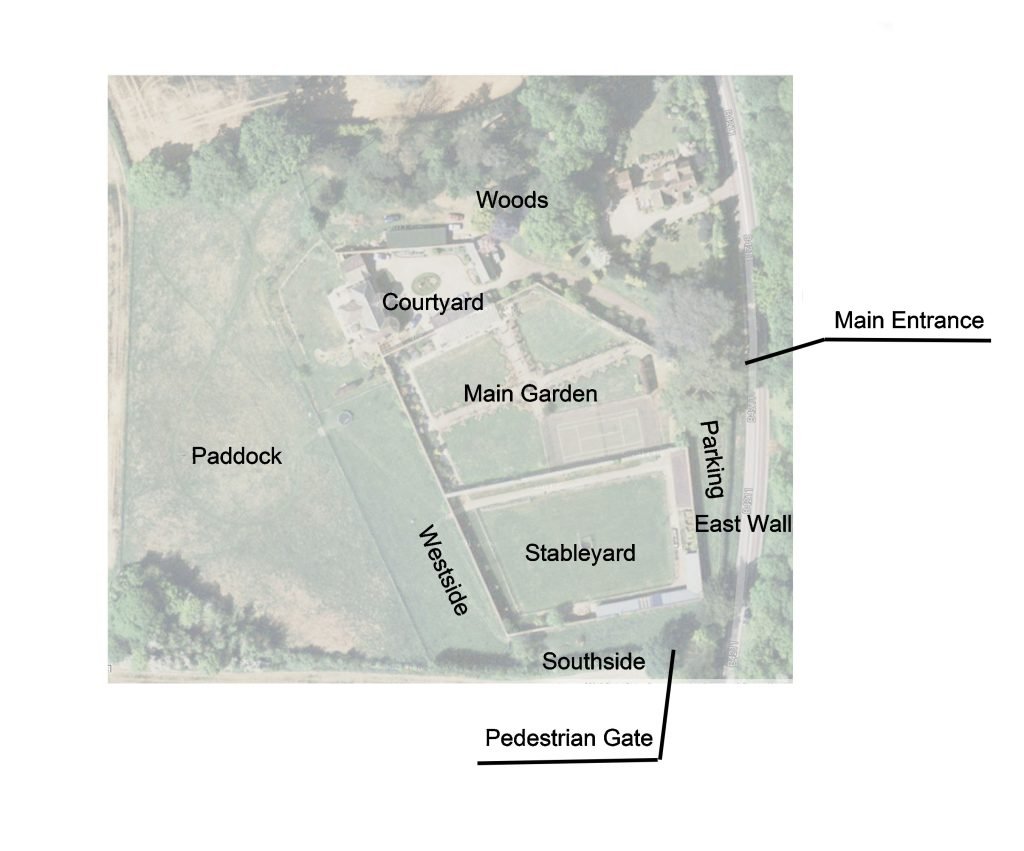Feel free to wander round in any order you like, but here’s a suggestion for a self-guided tour:
The Main Garden.

Originally when the gardens were ‘below stairs’ this would probably have been much less decorative
The credit for the present layout lies with an anonymous previous owner, the immediate previous owner neglected it and it was badly overgrown when we moved here but when we cleared things up we were delighted to find much of the original planting sprung back into life.
There are wonderful flowers through the year and you can also enjoy the heady smell of the Wisteria in the spring and the Lavender later on which not only smells gorgeous but the hum of the bees stocking up on nectar fills the garden on a summers evening.
The central pond is over 3m deep and was originally a dipping pond where gardeners would fill their buckets. Dorothy Bowen, who still lives in the village, worked here just after the war and remembers the dipping pond still in use.
The original garden builders were very concerned to make sure there was enough water, besides the well, rainwater was collected from the greenhouse roofs in brick underground tanks (the one in this garden still works) and water was pumped up from the Pool Brook by a mill.
The Greenhouse.
Once there were at least 5 greenhouses, this is the last one standing and when we arrived it was threatening to fall down so we had to do something about it. We dismantled it and refurbished all the metalwork replacing all the glass in the process and this took months of glass cutting as all the panes were cut by hand. The scalloped design is not only beautiful but is designed to make the rain run down the centre of the glass keeping it off the frame of the greenhouse. The rainwater is collected in an underground tank on the east end of the greenhouse.
The greenhouse was originally split into two zones heated by fires in the north wall through a labyrinth of chimneys.
The Courtyard.
Originally hosted two greenhouses and on the north facing wall there was a mushroom house. What is now our holiday cottage (See Rhyddcottage.co.uk) was used to pack up the produce for market when Rhydd Gardens was a commercial market garden, hence the other name of the cottage ’The Packing House’. Opposite the cottage the house was originally the head gardeners cottage and the basement used to store flowers en-route to the big house or to market.
The Woods.
A lovely place to be on a hot day and at night we have resident Owls. The Yew trees were planted to shelter the gardens from the cold northerly winds.
As you walk up the driveway you can see the well and the base of what would have been a stationary engine pumping water from over 20m below. Ask me about the gruesome history of the well.
East Wall.
Passing under the massive Cedar trees you will see on the east wall a row of apple trees which we planted in espalier / cordons to echo the original planting pattern of the gardens. You can still see the lead variety labels in the walls in many places – there are about 80 left, but there must have been a couple of hundred originally.
Southside.
The bees are newly arrived courtesy of local beekeeper Peter Stenson, the hive on the far right is a swarm we found in one of the trees in the stableyard and gave a new home. I love the bees but suggest you give them a wide berth just in case.
A future fruit and veg area we have the new fruit trees in place against the south facing wall as they would have been originally
Things to look out for;
Free range asparagus
Stoats
Lead plant labels
West Side.
A cracking view of the Malvern ridge, a splendid curly hazel tree and some more fruit trees.
The Paddock.
We let this grow wild for the wildlife just running the topper over it once or twice a year to keep it as a meadow. We have mown some paths to enjoy it more easily and provide a bit of entertainment: Topological challenge: (Mathematicians may think of the seven bridges problem) Can you walk all the paths without retracing your steps? (hint, try two laps)
The Stableyard.
A long time since horses were here, one day this may be a formal vegetable garden. One day.
Meanwhile the grape vines are very productive and we produce some of our own wine. Shame it is so awful.
The dipping pond is much shallower than the one in the main garden but was also fed from rainwater running off the two greenhouses on the north wall. Both were originally warmed by a heated wall and both long since demolished, now only visible on old maps.
Main Garden.
Where we started, and perhaps we have earned a cuppa by now.
